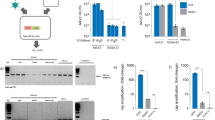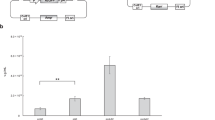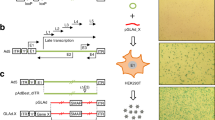Abstract
Recombinant adenoviruses are one of the most common vehicles for efficient in vitro and in vivo gene deliveries. Here, we investigate whether exogenous precursor terminal protein (pTP) expression in 293 cells improves the efficiency of adenovirus packaging and amplification. We used a piggyBac transposon-based vector and engineered a stable 293 line that expresses high level of Ad5 pTP, designated as 293pTP. Using the AdBMP6-GLuc that expresses green fluorescent protein (GFP), BMP6 and Gaussia luciferase, we found that the infectivity of AdBMP6-GLuc viral samples packaged in 293pTP cells was titrated up to 19.3 times higher than that packaged in parental 293 cells. AdBMP6-GLuc viral samples packaged in 293pTP cells exhibited significantly higher transduction efficiency in 143B and immortalized mouse embryonic fibroblast (iMEF) cells, as assessed by fluorescence-activated cell sorting analysis of GFP-positive cells, the luciferase activity assay and BMP6-induced osteogenic marker alkaline phosphatase activities in iMEFs. When adenovirus amplification efficiency was analyzed, we found that 293pTP cells infected with AdBMP6-GLuc yielded up to 12.6 times higher titer than that in parental 293 cells, especially at lower multiplicities of infection. These results strongly suggest that exogenous pTP expression may accelerate the packaging and amplification of recombinant adenoviruses. Thus, the engineered 293pTP cells should be a superior packaging line for efficient adenovirus production.
This is a preview of subscription content, access via your institution
Access options
Subscribe to this journal
Receive 12 print issues and online access
$259.00 per year
only $21.58 per issue
Buy this article
- Purchase on Springer Link
- Instant access to full article PDF
Prices may be subject to local taxes which are calculated during checkout






Similar content being viewed by others
References
Breyer B, Jiang W, Cheng H, Zhou L, Paul R, Feng T et al. Adenoviral vector-mediated gene transfer for human gene therapy. Curr Gene Ther 2001; 1: 149–162.
Kay MA, Glorioso JC, Naldini L Viral vectors for gene therapy: the art of turning infectious agents into vehicles of therapeutics. Nat Med 2001; 7: 33–40.
Lou J, Xu F, Merkel K, Manske P Gene therapy: adenovirus-mediated human bone morphogenetic protein-2 gene transfer induces mesenchymal progenitor cell proliferation and differentiation in vitro and bone formation in vivo. J Orthop Res 1999; 17: 43–50.
St George JA Gene therapy progress and prospects: adenoviral vectors. Gene Ther 2003; 10: 1135–1141.
Kay MA State-of-the-art gene-based therapies: the road ahead. Nat Rev Genet 2011; 12: 316–328.
Ketner G, Spencer F, Tugendreich S, Connelly C, Hieter P Efficient manipulation of the human adenovirus genome as an infectious yeast artificial chromosome clone. Proc Nati Acad Sci USA 1994; 9: 6186–6190.
Chartier C, Degryse E, Gantzer M, Dieterle A, Pavirani A, Mehtali M Efficient generation of recombinant adenovirus vectors by homologous recombination in Escherichia coli. J Virol 1996; 70: 4805–4810.
He TC, Zhou S, da Costa LT, Yu J, Kinzler KW, Vogelstein B A simplified system for generating recombinant adenoviruses. Proc Natl Acad Sci USA 1998; 95: 2509–2514.
Luo J, Deng ZL, Luo X, Tang N, Song WX, Chen J et al. A protocol for rapid generation of recombinant adenoviruses using the AdEasy system. Nat Protoc 2007; 2: 1236–1247.
Hardy S, Kitamura M, Harris-Stansil T, Dai Y, Phipps ML Construction of adenovirus vectors through Cre-lox recombination. J Virol 1997; 7: 1842–1849.
Ng P, Parks RJ, Cummings DT, Evelegh CM, Sankar U, Graham FL . A high-efficiency Cre/loxP-based system for construction of adenoviral vectors. Hum Gene Ther 1999; 10: 2667–2672.
Stillman BW The replication of adenovirus DNA with purified proteins. Cell 1983; 35: 7–9.
Liu H, Naismith JH, Hay RT Adenovirus DNA replication. Curr Top Microbiol Immunol 2003; 272: 131–164.
Lichy JH, Field J, Horwitz MS, Hurwitz J Separation of the adenovirus terminal protein precursor from its associated DNA polymerase: role of both proteins in the initiation of adenovirus DNA replication. Proc Natl Acad Sci USA 1982; 79: 5225–5229.
de Jong RN, van der Vliet PC Mechanism of DNA replication in eukaryotic cells: cellular host factors stimulating adenovirus DNA replication. Gene 1999; 236: 1–12.
Schaack J, Ho WY, Freimuth P, Shenk T . Adenovirus terminal protein mediates both nuclear matrix association and efficient transcription of adenovirus DNA. Genes Dev 1990; 4: 1197–1208.
Graham FL, Smiley J, Russell WC, Nairn R Characteristics of a human cell line transformed by DNA from human adenovirus type 5. J Gen Virol 1977; 36: 59–74.
Luther GA, Lamplot J, Chen X, Rames R, Wagner ER, Liu X et al. IGFBP5 Domains Exert Distinct Inhibitory Effects on the Tumorigenicity and Metastasis of Human Osteosarcoma. Cancer Lett 2013; 336: 222–230.
Huang E, Bi Y, Jiang W, Luo X, Yang K, Gao JL et al. Conditionally immortalized mouse embryonic fibroblasts retain proliferative activity without compromising multipotent differentiation potential. PLoS One 2012; 7: e32428.
Cheng H, Jiang W, Phillips FM, Haydon RC, Peng Y, Zhou L et al. Osteogenic activity of the fourteen types of human bone morphogenetic proteins (BMPs). J Bone Joint Surg Am 2003; 85-A: 1544–1552.
Kang Q, Sun MH, Cheng H, Peng Y, Montag AG, Deyrup AT et al. Characterization of the distinct orthotopic bone-forming activity of 14 BMPs using recombinant adenovirus-mediated gene delivery. Gene Ther 2004; 1: 1312–1320.
Luu HH, Song WX, Luo X, Manning D, Luo J, Deng ZL et al. Distinct roles of bone morphogenetic proteins in osteogenic differentiation of mesenchymal stem cells. J Orthop Res 2007; 25: 665–677.
Schaack J, Guo X, Ho WY, Karlok M, Chen C, Ornelles D . Adenovirus type 5 precursor terminal protein-expressing 293 and HeLa cell lines. J Virol 1995; 69: 4079–4085.
Langer SJ, Schaack J 293 cell lines that inducibly express high levels of adenovirus type 5 precursor terminal protein. Virology 1996; 221: 172–179.
Amalfitano A, Chamberlain JS Isolation and characterization of packaging cell lines that coexpress the adenovirus E1, DNA polymerase, and preterminal proteins: implications for gene therapy. Gene Ther 1997; 4: 258–263.
Lieber A, He CY, Kay MA Adenoviral preterminal protein stabilizes mini-adenoviral genomes in vitro and in vivo. Nat Biotechnol 1997; 15: 1383–1387.
Hoeben RC, Uil TG Adenovirus DNA replication. Cold Spring Harb Perspect Biol 2013; 5: a013003.
Mysiak ME, Wyman C, Holthuizen PE, van der Vliet PC . NFI and Oct-1 bend the Ad5 origin in the same direction leading to optimal DNA replication. Nucleic Acids Res 2004; 32: 6218–6225.
Gao Y, Huang E, Zhang H, Wang J, Wu N, Chen X et al. Crosstalk between Wnt/beta-catenin and estrogen receptor signaling synergistically promotes osteogenic differentiation of mesenchymal progenitor cells. PLoS One 2013; 8: e82436.
Kong Y, Zhang H, Chen X, Zhang W, Zhao C, Wang N et al. Destabilization of heterologous proteins mediated by the GSK3beta phosphorylation domain of the beta-catenin protein. Cell Physiol Biochem 2013; 32: 1187–1199.
Zhang W, Zhang H, Wang N, Zhao C, Zhang H, Deng F et al. Modulation of beta-Catenin Signaling by the Inhibitors of MAP Kinase, Tyrosine Kinase, and PI3-Kinase Pathways. Int J Med Sci 2013; 10: 1888–1898.
Chen X, Luther G, Zhang W, Nan G, Wagner ER, Liao Z et al. The E-F hand calcium-binding protein s100a4 regulates the proliferation, survival and differentiation potential of human osteosarcoma cells. Cell Physiol Biochem 2013; 32: 1083–1096.
Kang Q, Song WX, Luo Q, Tang N, Luo J, Luo X et al. A comprehensive analysis of the dual roles of BMPs in regulating adipogenic and osteogenic differentiation of mesenchymal progenitor cells. Stem Cells Dev 2009; 18: 545–559.
Huang J, Bi Y, Zhu GH, He Y, Su Y, He BC et al. Retinoic acid signalling induces the differentiation of mouse fetal liver-derived hepatic progenitor cells. Liver Int 2009; 29: 1569–1581.
Zhang W, Deng ZL, Chen L, Zuo GW, Luo Q, Shi Q et al. Retinoic acids potentiate BMP9-induced osteogenic differentiation of mesenchymal progenitor cells. PLoS One 2010; 5: e11917.
Zhu GH, Huang J, Bi Y, Su Y, Tang Y, He BC et al. Activation of RXR and RAR signaling promotes myogenic differentiation of myoblastic C2C12 cells. Differentiation 2009; 78: 195–204.
Rastegar F, Gao JL, Shenaq D, Luo Q, Shi Q, Kim SH et al. Lysophosphatidic acid acyltransferase beta (LPAATbeta) promotes the tumor growth of human osteosarcoma. PLoS One 2010; 5: e14182.
Su Y, Wagner ER, Luo Q, Huang J, Chen L, He BC et al. Insulin-like growth factor binding protein 5 suppresses tumor growth and metastasis of human osteosarcoma. Oncogene 2011; 30: 3907–3917.
Peng Y, Kang Q, Luo Q, Jiang W, Si W, Liu BA et al. Inhibitor of DNA binding/differentiation helix-loop-helix proteins mediate bone morphogenetic protein-induced osteoblast differentiation of mesenchymal stem cells. J Biol Chem 2004; 279: 32941–32949.
Peng Y, Kang Q, Cheng H, Li X, Sun MH, Jiang W et al. Transcriptional characterization of bone morphogenetic proteins (BMPs)-mediated osteogenic signaling. J Cell Biochem 2003; 90: 1149–1165.
Sharff KA, Song WX, Luo X, Tang N, Luo J, Chen J et al. Hey1 basic helix-loop-helix protein plays an important role in mediating bmp9-induced osteogenic differentiation of mesenchymal progenitor cells. J Biol Chem 2009; 284: 649–659.
Liu X, Qin J, Luo Q, Bi Y, Zhu G, Jiang W et al. Cross-talk between EGF and BMP9 signalling pathways regulates the osteogenic differentiation of mesenchymal stem cells. J Cell Mol Med 2013; 17: 1160–1172.
Zhang J, Weng Y, Liu X, Wang J, Zhang W, Kim SH et al. Endoplasmic reticulum (ER) stress inducible factor cysteine-rich with EGF-like domains 2 (Creld2) is an important mediator of BMP9-regulated osteogenic differentiation of mesenchymal stem cells. PLoS One 2013; 8: e73086.
Luo X, Chen J, Song WX, Tang N, Luo J, Deng ZL et al. Osteogenic BMPs promote tumor growth of human osteosarcomas that harbor differentiation defects. Lab Invest 2008; 88: 1264–1277.
Luo Q, Kang Q, Si W, Jiang W, Park JK, Peng Y et al. Connective tissue growth factor (CTGF) Is regulated by Wnt and bone morphogenetic proteins signaling in osteoblast differentiation of mesenchymal stem cells. J Biol Chem 2004; 279: 55958–55968.
Tang N, Song WX, Luo J, Luo X, Chen J, Sharff KA et al. BMP9-induced osteogenic differentiation of mesenchymal progenitors requires functional canonical Wnt/beta-catenin signaling. J Cell Mol Med 2009; 13: 2448–2464.
Chen L, Jiang W, Huang J, He BC, Zuo GW, Zhang W et al. Insulin-like growth factor 2 (IGF-2) potentiates BMP-9-induced osteogenic differentiation and bone formation. J Bone Miner Res 2010; 25: 2447–2459.
Bi Y, Huang J, He Y, Zhu GH, Su Y, He BC et al. Wnt antagonist SFRP3 inhibits the differentiation of mouse hepatic progenitor cells. J Cell Biochem 2009; 108: 295–303.
Yang K, Chen J, Jiang W, Huang E, Cui J, Kim SH et al. Conditional immortalization establishes a repertoire of mouse melanocyte progenitors with distinct melanogenic differentiation potential. J Invest Dermatol 2012; 132: 2479–2483.
Wang X, Cui J, Zhang BQ, Zhang H, Bi Y, Kang Q et al. Decellularized liver scaffolds effectively support the proliferation and differentiation of mouse fetal hepatic progenitors. J Biomed Mater Res 2013; 102: 1017–1025.
Acknowledgements
The reported work was supported in part by research grants from the National Institutes of Health (RCH, T-CH and HHL), and the 973 Program of the Ministry of Science and Technology (MOST) of China (# 2011CB707906 to T-CH). This project was also supported in part by the National Center for Advancing Translational Sciences of the National Institutes of Health through Grant Number UL1 TR000430.
Author information
Authors and Affiliations
Corresponding author
Ethics declarations
Competing interests
The authors declare no conflict of interest.
Rights and permissions
About this article
Cite this article
Wu, N., Zhang, H., Deng, F. et al. Overexpression of Ad5 precursor terminal protein accelerates recombinant adenovirus packaging and amplification in HEK-293 packaging cells. Gene Ther 21, 629–637 (2014). https://doi.org/10.1038/gt.2014.40
Received:
Revised:
Accepted:
Published:
Issue Date:
DOI: https://doi.org/10.1038/gt.2014.40
This article is cited by
-
BMP4 upregulates glycogen synthesis through the SMAD/SLC2A1 (GLUT1) signaling axis in hepatocellular carcinoma (HCC) cells
Cancer & Metabolism (2023)
-
Enhanced oncolytic adenoviral production by downregulation of death-domain associated protein and overexpression of precursor terminal protein
Scientific Reports (2021)
-
BMP9-induced osteoblastic differentiation requires functional Notch signaling in mesenchymal stem cells
Laboratory Investigation (2019)
-
Characterization of retroviral infectivity and superinfection resistance during retrovirus-mediated transduction of mammalian cells
Gene Therapy (2017)
-
Antibiotic monensin synergizes with EGFR inhibitors and oxaliplatin to suppress the proliferation of human ovarian cancer cells
Scientific Reports (2015)



